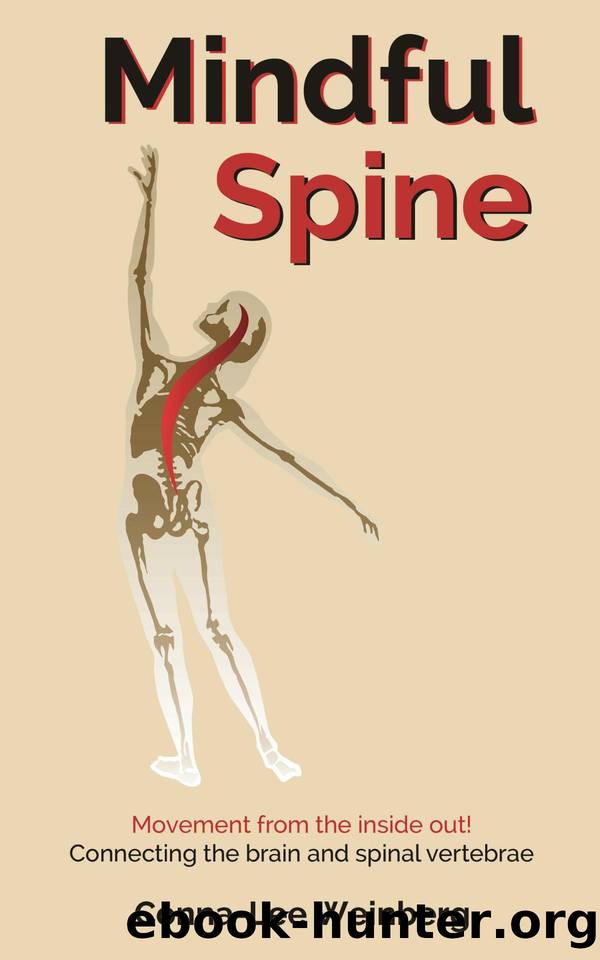Mindful Spine by Weinberg Conna-Lee

Author:Weinberg, Conna-Lee [Weinberg, Conna-Lee]
Language: eng
Format: epub
Publisher: UNKNOWN
Published: 2017-04-03T16:00:00+00:00
The drawing on the left shows a strong cervical and thoracic spine. The drawing on the right shows a weak cervical and thoracic spine. Notice the collapsing of the neck and chest area and the rounded upper thoracic spine, which takes the shoulders to a position where they “appear” more forward.
The action of pulling the shoulders back will never help to address or change an unconscious and weak thoracic spine. In fact, pulling the shoulders back will only teach the adolescent’s brain a new incorrect postural connection in an equally tense and uncomfortable position, just in another direction. This will contribute to added tension on their already weak cervical and thoracic spine. The problem isn’t the shoulders; your shoulders actually should naturally fit and appear slightly forward on your skeleton.
Much time, effort, and money are spent in numerous teaching articles that address posture. Regardless of all the information about alignment and posture, none shows proof that any of this is working. People with good posture or what we think and have learned is good posture suffer pain, just as those with what is considered poor posture. It is time we take a new look at what posture really is within our living bodies. Adolescents in this country have memorized the exact ancient date Columbus sailed the ocean and discovered America, but they don’t seem to know much about their own living spine or that they have a rib right near their cervical neck!
With so many zombie movies prevalent today it shouldn’t seem too far-fetched for a teenager to imagine what it would be like if they were to look in the mirror and see their skeleton. Of course we can’t, but there are other ways to see similarly to how you learned to find and connect to the movement of each and every one of your fingers without looking. Visually picturing the skeleton in this way, adolescents would begin to understand what is required within themselves to change their own posture. They would know why their shoulder is forward, then find, feel, and move directly from their thoracic spine, ribcage, or humeral bone. The current non-productive energy we spend within our bodies trying to improve our posture exhausts our bodies and is hard work that doesn’t even address our true structural posture. It is this non-productive energy that does not strengthen our actual spine, so therefore we think we need to repeat “core” strengthening over and over again because we never feel like we get strong enough or get the exercise down just right. This is simply why we don’t like to “work” on our posture. When you consciously connect to your spine, it is productive work to align your spine! And once learned it becomes a simple easy adjustment that soon strengthens and naturally knows where to be !
What Messages Are We Sending to Our Spine and Skeletal System as Adults?
Download
This site does not store any files on its server. We only index and link to content provided by other sites. Please contact the content providers to delete copyright contents if any and email us, we'll remove relevant links or contents immediately.
Tools of Titans by Timothy Ferriss(7815)
Bodyweight Strength Training by Jay Cardiello(7676)
Born to Run: by Christopher McDougall(6895)
Inner Engineering: A Yogi's Guide to Joy by Sadhguru(6441)
Asking the Right Questions: A Guide to Critical Thinking by M. Neil Browne & Stuart M. Keeley(5357)
The Fat Loss Plan by Joe Wicks(4622)
Bodyweight Strength Training Anatomy by Bret Contreras(4472)
Yoga Anatomy by Kaminoff Leslie(4103)
Science and Development of Muscle Hypertrophy by Brad Schoenfeld(3971)
Dynamic Alignment Through Imagery by Eric Franklin(3920)
ACSM's Complete Guide to Fitness & Health by ACSM(3824)
The Four-Pack Revolution by Chael Sonnen & Ryan Parsons(3795)
Exercise Technique Manual for Resistance Training by National Strength & Conditioning Association(3788)
Bodyweight Strength Training: 12 Weeks to Build Muscle and Burn Fat by Jay Cardiello(3781)
Yoga Anatomy by Leslie Kaminoff & Amy Matthews(3740)
The Ultimate Bodybuilding Cookbook by Kendall Lou Schmidt(3708)
Yoga Therapy by Mark Stephens(3574)
Nutrition for Sport, Exercise, and Health by Spano Marie & Kruskall Laura & Thomas D. Travis(3556)
Nutrition for Sport, Exercise, and Health by Marie Spano & Laura Kruskall & D. Travis Thomas(3548)
